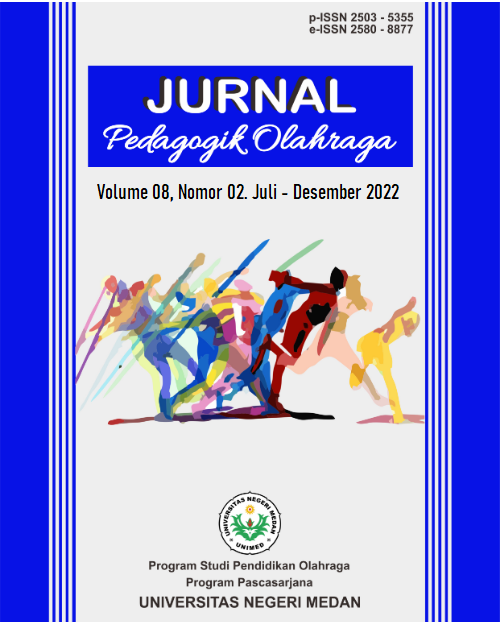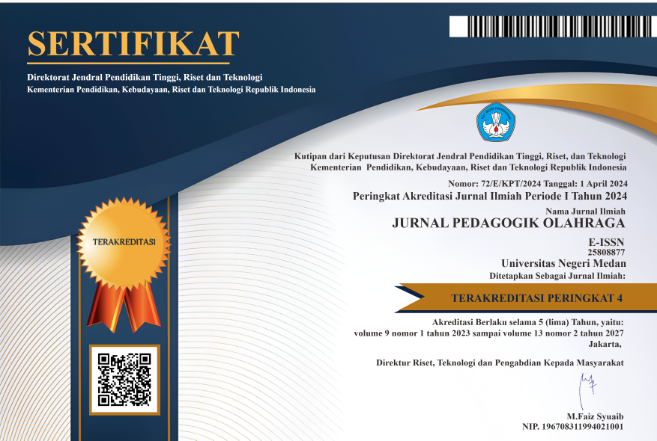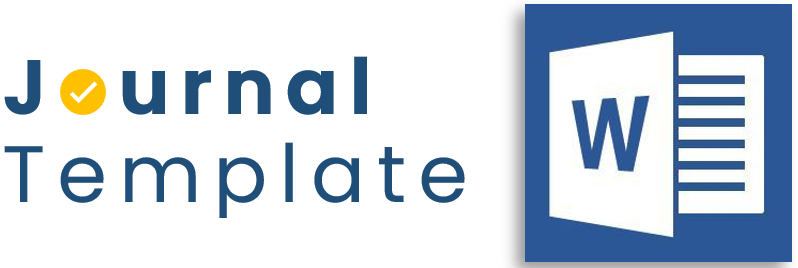MEKANISME AKTIVITAS FISIK Fast Interval Training SEBAGAI PENATALAKSANAAN PENURUNAN KADAR ASAM URAT PADA PENDERITA HIPERURISEMIA: META ANALISIS- REVIEW
DOI:
https://doi.org/10.24114/jpor.v9i1.46587Keywords:
Metabolisme, Aktivitas fisik, Asm urat, olahraga.Abstract
Hiperurisemia dapat disebabkan oleh keadaan sindrom metabolik. Penyakit yang melibatkan kelainan metabolisme dari metabolisme purin atau nukleotida meliputi banyak ragam jenis kelainan namun pada umumnya meliputi Hiperurisemia dan juga Gout. Dalam kasus konsumsi purin yang berlebih akan memberikan efek gangguan eksresi produk metabolik akhir metabolisme purine atau asam urat. aktivitas fisik seperti olahraga teratur dapat mencegah terhadap banyaknya produksi dan penimbunan asam urat, dan tidak menentukan lamanya pelaksanaan aktivitas fisik berupa olahraga yang diberian untuk penderita Hiperurisemia. Artikel ini membuktikan analisa pengaruh aktivitas fisik FIT (Fast Interval Training) menyebabkan penurunan kadar asam urat melalui mekanisme perubahan molekuler dengan menggunakan artikel dari 10 tahun belakangan. Metode penulisan artikel ini menggunakan Technical Expert Panel (TEP) dari 4 orang yang memiliki ahli dibidang kesehatan, hasil review di tulis dengan desaign (PRISMA-ScR) Reviews and Meta Analyses Extension for scoping Reviews model. Menggunakan pencarian kata kunci pencarian œAktivitas fisik dan œAsam urat . Hasil penelitian diperoleh dari 90 artikel yang di analisa, diperoleh 10 penelitian yang sesuai dan fokus dengan kajian mencakup hasil penelitian, review, maupun case report. Sehingga hasil akhir meyimpulkan bahwa diperoleh hubungan aktivitas fisik tipe Fast Interval Training terhadap penurunan kadar asam urat.References
Andriyani. 2021. Kajian pada ekspresi transporter URAT1, GLUT9 dan SGLT2 = Effect of α-mangostin on kidney function and plasma uric acid level of insulin resistance rat model: Focus on URAT1, GLUT9 and SGLT2 transporters expression. Tesis Magister Universitas Indonesia. Universitas Indonesia
Alvarez LC, Ramirez-campillo R, Flores OM, Henriquez-olquin C, Campus JC, Carrasco V, Martinez SC, Cells-morales C. 2013. Metabolic response to high intensity exercise training in sedentary hyperglycemic and hypercholesterolemic women. Rev.Med. Chil.2013.Oct:141(10):1293-9
Bompa TO and Haff GG. 2009. Periodization : Theory and Methodology of Training (5th Ed). Champaign, Illinois : Human Kinetics publishers.
Carter, M. A., 2006, Gout, dalam Sylvia, A. P. And Lorraine, M. W. (Eds), Patofisiologi, Konsep Klinis Proses-proses Penyakit, Edisi VI, Buku II, 1242-1246, Penerbit Buku Kedokteran EGC, Jakarta
Demakakos P, Hamer M, Stamatakis E, & Steptoe A. 2010. Low-intensity physical activity is associated with reduced risk of incident type 2 diabetes in older adults: evidence from the English Longitudinal Study of Ageing. Diabetologia, 53(9), 1877-1885
Dimas A, Advitasari YD and Nugraheni B. 2020. Aktivitas Antihiperurisemia mikroenkapsulasi ekstrak kulit melinjo (Gnetum gnemon L) Secara In vivo. Vol 9 No 1 pp 1-6
Gibala MJ. 2007. High-Intensity Interval Training: New Insights. Sports Science Exchange. Volume 20;2:105-112
Gutiérrez-Rodelo C, Roura-Guiberna A, and Olivares-Reyes JA. 2017. Molecular
Mechanisms of Insulin Resistance: An Update. Gac Med Mex. 153:197-209
Guido L, Franco D, Sorriento D, Strisciuglio T, Barbato E and Morisco C. 2021. Modulation of Insulin Sensitivity by Exercie Training: Implications for Cardiovascular Prevention. Journal of Cardiovascular Translational Research. 14: 256 “ 270
Harahap, AM and Machrina Y. 2023. Effects of physical activity fast interval training and provision of melinjo skin extract (gnetum gnemon) on expression of urat1 transporter, GLUT9 and SGLT2 in hyperuricemia insulin resistance. The Journal of Bioscience. 8(1). Pp: 14-23. DOI: https://doi.org/10.24114/jbio.v8i1.29105
Hasan AE, Husnawati and Setiyono A. 2020. Efektivitas ekstrak kulit melinjo (Gnetum gnemon) pada penurunan kadar asam urat paad tikus putih (rattus novergicus) hiperurisemia. Curr Biochem.2020. 7(1): 21-28
Hawleyand Bird RS. 2017. Update on the effects of physical activity on insulin sensitivity in humans. BMJ Open Sport Exerc Med 2017;2:e000143.
Joshua L, Aaron V, Jason F and Irving H. 1985. Hyperuricemia in Glycogen Storage Disease Type I. Journal of Clinic Investigation The american Society for clinical Investigation. Vol 75 No 2. 251-257
Kahka HM, Moazami M and Rajaelan N. 2020. The comparison of effect of high intensity ingterval training compared to aerobic training on serum levels of some of stress activated protein kinase and glucose in type II diabetic men with periperal Neurophaty. Journal of critical freviews. Vol 7 No 88
Katsutaro M, Petersen KF and Shulman GI. 2006. Molecular Mechanism of Insulin Resistance in Humans and Their Potential Links with Mitochondrial Dysfunction. Journal report of Diabetes. Vol 55: 9-15
Karstoft K, Winding K, Knudsen SH et al (2014) Mechanisms behind the superior effects of interval vs continuous training on Diabetologiaglycaemic control in individuals with type 2 diabetes: a randomised controlled trial. Diabetologia 57:2081“2093
Katz PM, Leiter L.A. 2015. The role of the kideney and SGLT2 Inhibitors in type 2 diabetes. Canadian Journal of diabetes. 39(5): S167-75
Koivula R, Atabaki R, Giordano G and whitw et al. 2019. The role of physical activity in metabolic homestasis before and after onset type 2 diabetes: an IMI DIRECT: Article. Doi.org/10.1007/soo125-019-05083-6
Kurniati A. 2011. Hubungan antara Retinopati Diabetika dan Hiperurisemia dengan Gangguan Kognitif pada Penderita Stroke Iskemik. Tesis. Semarang. Universitas Diponegoro.
Moser O, Tschakert G, Mueller A, Groeschl W, Pieber TR, Obermayer-Pietsch B, et.al. 2015. Effects of High-Intensity Interval Exercise versus Moderate Continuous Exercise on Glucose Homeostasis and Hormone Response in Patients with Type 1 Diabetes Mellitus Using Novel Ultra-Long-Acting Insulin. PLOS ONE | DOI:10.1371/journal. p 1-17
Sigal RJ, Kenny G P, Boule NG , Wells GA, Prud™homme D, Fortier M, et al. 2007. Effects of aerobic training, resistance training, or both on glycemic control in type 2 diabetes. Ann Intern Med. 2007;147:357-369. Available at www.annals.org.
Skleryk JR, Karagounis LG, Hawley JA, Sharman MJ, Laursen PB, et al. 2013. Two weeks of reduced volume sprint interval or traditional exercise training does not improve metabolic functioning in sedentary obese men. Diabetes Obes Metab. 15:1146“1153
Sherwood L. 2014. Human Physiology From Cells to Systems. Seventh edition. Brooks/Cole. Chapter 19. p 717-718.
Stanford KI and Goodyear L J. 2014. Exercise and type 2 diabetes: molecular mechanisms regulating glucose uptake in skeletal muscle. Adv Physiol Educ 38: 308“314, 2014
World Health Organization. 2010. Prevalence and management of Hyperuricemia
Yinqiu Y, Zhao C, Ye Y, Yu M and Qu X. 2020. Prospect of sodium Glucose Co Transporter 2 Inhibitors combined with Insulin for the Treatment of Type 2 Diabetes. Journal Frontiers of Endocrinology. Doi.org. 10.3389/ fendo. 2020. 00190
Yetti Machrina, Harun Al Rasyid Damanik, Ambrosius Purba, dan Dharma Lindarto. 2019. Effect Various type of exercise to Insr Gene expression skeletal muscle insuline receptor and Insuline resistence On Diabetes Mellitus Type-2 model Rats. International Journal of Healts Science. Volume 6 No 4: 50-56
Yong Park, D., Soo Kim, Y., Ho Ryu, S., & Sun Jin, Y. 2019. The association between sedentary behavior, physical activity and hyperuricemia. Vascular Health and Risk Management, 15, 291“299. https:// doi.org/ 10.2147/ VHRM. S20027. 8.
Downloads
Published
How to Cite
Issue
Section
License
Copyright (c) 2023 Jurnal Pedagogik Olahraga

This work is licensed under a Creative Commons Attribution 4.0 International License.
Jurnal Pedagogik Olahraga is licensed under a Creative Commons Attribution 4.0 International License
Penulis yang menerbitkan jurnal ini menyetujui persyaratan berikut:
- Penulis memegang hak cipta dan memberikan hak jurnal untuk publikasi pertama dengan karya yang dilisensikan secara bersamaan di bawah Lisensi Atribusi Creative Commons yang memungkinkan orang lain untuk membagikan karya tersebut dengan pengakuan atas penulisan karya dan publikasi awal dalam jurnal ini.
- Penulis dapat membuat pengaturan kontrak tambahan yang terpisah untuk distribusi non-eksklusif dari versi terbitan jurnal dari karya tersebut (misalnya, mempostingnya ke penyimpanan institusional atau menerbitkannya dalam sebuah buku), dengan pengakuan dari publikasi awalnya di jurnal ini.
- Penulis diizinkan dan didorong untuk memposting karya mereka secara online (misalnya, di repositori institusional atau di situs web mereka) sebelum dan selama proses pengiriman, karena hal itu dapat mengarah pada pertukaran yang produktif, serta kutipan yang lebih awal dan lebih besar dari karya yang diterbitkan.









